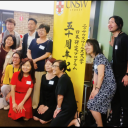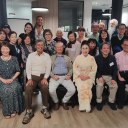第110回
Japanese Culture
オージーに英語で説明してみよう!
日本人には常識でも、文化の違うオージーにはイマイチ伝えづらい……。そんな時にぴったりの表現や話の流れをご紹介。
文:池田俊一 オーストラリア国立大学アジア・太平洋カレッジ日本センター
協力:池田澪奈
What is kintsugi?
「金継ぎ」って何?
「上司が『金継ぎ作品の展示会に行って、とても感動した』と言っていたけれど、これってどういう意味?」
Aussie: I ended up listening to how he went to this exhibit ion and really enjoyed it, but I still have no clue about what 金継ぎ (kintsugi) is actually about.
Aussie: Oh, I think I know the ones. They’re very beautiful.
You: Yes, they’re very unique, too. Every repaired 金継ぎ piece is one-of-a-kind, because of the randomness with which ceramics shatters and the irregular patterns formed that are enhanced with the use of various precious metals.
Aussie: How long has this practice been around for?
You: It’s said to be thousands of years old—archaeologists have found objects such as combs and lacquered trays in the Shimahama Tomb in Fukui prefecture dating all the way back to the Jōmon Period (about 5000 years ago)!
Aussie: Wow, that’s amazing.
You: As a philosophy, 金継ぎ can be seen to have similarities to the Japanese concept of wabi-sabi—an embracing of the flawed or imperfect. When you think of ‘repair work’ in general, it’s usually done in a concealed manner, so that the previous damage(s) done to it cannot be easily seen. But 金継ぎ products highlight and enhance the breaks, simply as an event in the life of an object, rather than allowing its service to end at the time of its breakage.
Aussie: It definitely goes hand-in-hand with the sustainable living movement that is becoming more prominent these days, and I for one, would gladly support this becoming more of a thing over here!
You: Absolutely. So much already goes to waste.
Aussie: It’s not recycling in the traditional sense, but it’s certainly a rejuvenating method.
説明する時のポイント
「金継ぎ」は、陶器や磁器が割れたり、欠けたり、ヒビが入ったりした時に、その破損した部分を漆(うるし)って接着し、その部分を金や銀、白金などの金属粉で装飾して仕上げる修復技法のことを指すと説明してあげよう。対話文にもあるように、縄文土器にも破損部分を漆で修復した痕跡が見られるほど、漆を使った修復技法は古くから伝わっていると教えてあげよう。室町時代以降、修理した部分をありのままに受け入れる茶道精神の普及により、金属粉を使った修復部分にも芸術的価値が見出されるようになったと補足しておこう。現代でも、愛用の器を修理して長く使い続けたり、金継ぎそのものの過程を楽しんだり、アートの一貫で趣味として楽しむ人も多く、金継ぎを請け負う仕事をしている人もいれば、この修復技法を学ぶ体験教室も存続していると付け加えておくことも忘れずに。
【単語・成句】
end up ~ 結局(~する)ことになる
is actually about 実際に何なのか
porcelain 磁器
earthenware 陶器/土器
resin 樹脂/松脂
lacquer 漆
one-of-a-kind 唯一の
randomness 成り行き任せ/勝手気まま
shatter 割れる/欠ける/ヒビが入る
enhance 高める/強める/増す
archaeologist 考古学者
embrace 受け入れ/容認/歓迎
flawed 傷もの/ヒビ割れた
conceal 隠す/見えないようにする
breakage 破損/破壊
go hand-in-hand 相伴う/軌を一(いつ)にする
sustainable 持続可能な
【会話文で使える表現】
“I for one” という表現は、「少なくとも自分は/自分としては」という意味で、主に自分が何かに賛同/賛成する時に使われる。
【例1】
“The Government is strongly encouraging everyone to get their vaccinations.” “I for one endorse this very much.”
「政府は、国民がワクチン接種を受けることを強く勧めている」「自分も大賛成だね」
【例2】
“There are natural disasters happening around the world lately, aren’t they?” “Yes, and I for one, can’t help but feel like it’s linked to global warming.”
「最近、世界各国で自然災害が起きているね」「うん、少なくとも自分は地球温暖化が問題だという気がするよ」
【例3】
“Call me old-fashioned, but I for one, still like taking notes with pen and paper.”
「時代遅れかもしれないけど、自分にとっては、ペンと紙を使ってノートを取るのが好ましい」












You: Your boss probably should have explained it at the start, before telling you about his whole trip there… Anyway, 金 継ぎ is a traditional Japanese art form, where broken porcelain or earthenware is repaired using resin or lacquer mixed with powdered and liquid gold, silver, or platinum. The term 金継ぎ, or 金繕い (kintsukuroi), brings together the words “golden” [金 ‘kin’] and “ joinery” [継ぎ ‘tsugi’] / “repairs” [繕い ‘tsukuroi’].